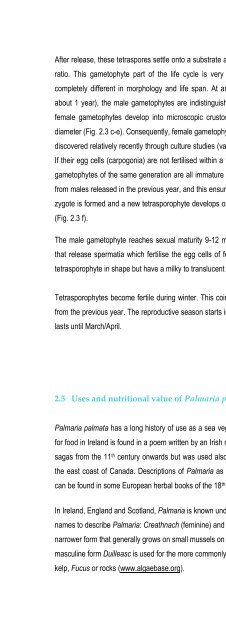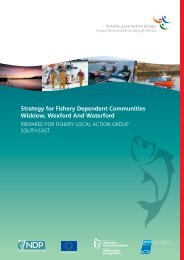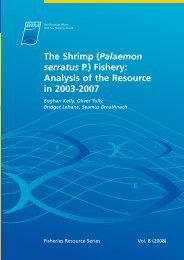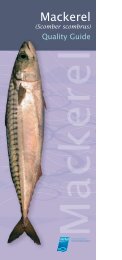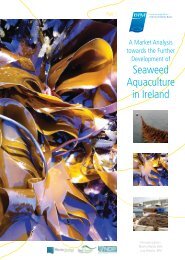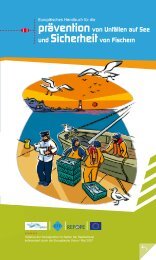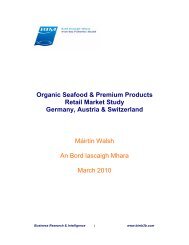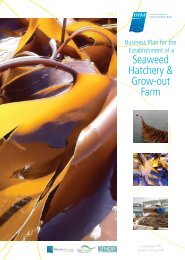Cultivating Palmaria palmata - Bord Iascaigh Mhara
Cultivating Palmaria palmata - Bord Iascaigh Mhara
Cultivating Palmaria palmata - Bord Iascaigh Mhara
Create successful ePaper yourself
Turn your PDF publications into a flip-book with our unique Google optimized e-Paper software.
After release, these tetraspores settle onto a substrate and develop into male and female gametophytes in a 1:1<br />
ratio. This gametophyte part of the life cycle is very unusual among algae in that males and females are<br />
completely different in morphology and life span. At an immature stage (i.e. before reproduction begins after<br />
about 1 year), the male gametophytes are indistinguishable from the diploid tetrasporophytes. In contrast, the<br />
female gametophytes develop into microscopic crustose thalli, no more than 3-4 cells thick and 0.1 mm in<br />
diameter (Fig. 2.3 c-e). Consequently, female gametophytes cannot be detected on the shore and they were only<br />
discovered relatively recently through culture studies (van der Meer & Chen, 1979; van der Meer & Todd, 1980).<br />
If their egg cells (carpogonia) are not fertilised within a few days, the female gametophytes die. Since the male<br />
gametophytes of the same generation are all immature at this stage, the females must be fertilised by gametes<br />
from males released in the previous year, and this ensures a good mixing of genetic material. After fertilisation, a<br />
zygote is formed and a new tetrasporophyte develops on top of the female gametophyte, and soon overgrows it<br />
(Fig. 2.3 f).<br />
The male gametophyte reaches sexual maturity 9-12 months after germination. Spermatangial sori are formed<br />
that release spermatia which fertilise the egg cells of female gametophytes. The sori resemble the sori of the<br />
tetrasporophyte in shape but have a milky to translucent appearance.<br />
Tetrasporophytes become fertile during winter. This coincides with the reproductive time of male gametophytes<br />
from the previous year. The reproductive season starts in November-December at most sites around Ireland and<br />
lasts until March/April.<br />
2.5 Uses and nutritional value of <strong>Palmaria</strong> <strong>palmata</strong><br />
<strong>Palmaria</strong> <strong>palmata</strong> has a long history of use as a sea vegetable. The earliest record of the collection of <strong>Palmaria</strong><br />
for food in Ireland is found in a poem written by an Irish monk in the 12 th century. It is also mentioned in Icelandic<br />
sagas from the 11 th century onwards but was used also in other countries such as Norway and France and on<br />
the east coast of Canada. Descriptions of <strong>Palmaria</strong> as a herbal remedy against, for example, worm infestation<br />
can be found in some European herbal books of the 18 th century (www.algaebase.org).<br />
In Ireland, England and Scotland, <strong>Palmaria</strong> is known under the name Dulse or Dillisk. In Gaelic, there are two<br />
names to describe <strong>Palmaria</strong>: Creathnach (feminine) and Duileasc (masculine). The first describes a smaller,<br />
narrower form that generally grows on small mussels on more exposed shores, also called “Shell-dulse”. The<br />
masculine form Duilleasc is used for the more commonly distributed larger, broader form that grows directly on<br />
kelp, Fucus or rocks (www.algaebase.org).<br />
17


